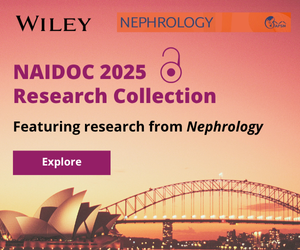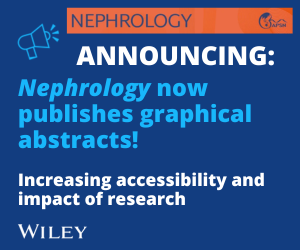Journal list menu
Export Citations
Download PDFs
ACUTE RENAL DISEASE
Urinary serum- and glucocorticoid-inducible kinase SGK1 reflects renal injury in patients with immunoglobulin A nephropathy
- Pages: 307-317
- First Published: 06 March 2014
The present study demonstrates that one of a serine-threonine protein kinase, SGK1 levels in urine is associated with severe pathologic lesions in renal tissues, and subsequent renal insufficiency in IgAN.
Soluble CD25 is increased in patients with sepsis-induced acute kidney injury
- Pages: 318-324
- First Published: 20 March 2014
The authors evaluated the performance of soluble CD25 as a new biomarker for septic AKI. They collected blood and urine samples from critically ill patients treated in ICU. Among several different biomarkers including NGAL, the authors found sCD25 and IL-10 in addition to NGAL were significantly increased in septic AKI.
PROGRESSIVE CHRONIC RENAL DISEASE
Metabolic syndrome and chronic kidney disease in a Southern Chinese population
- Pages: 325-331
- First Published: 18 February 2014
This cross-sectional study of 1724 community-based participants in Southern China assesses the presence of metabolic syndrome and shows its association with CKD. The identification of predictors for CKD can lead to strategies such as excercise and weight reduction to reduce adverse outcomes and may help to delay the development and progression of CKD.
GENERAL NEPHROLOGY
Effectiveness of supine/standing urinalysis for differential diagnosis of left renal vein entrapment syndrome combined with or without glomerulopathy
- Pages: 332-338
- First Published: 13 March 2014
An interesting paper demonstrates supine/standing urinalysis combined with Doppler sonography can be helpful for differential diagnosis of left renal vein entrapment syndrome from glomerulopathy.
DIALYSIS
Effect of cinacalcet treatment on vascular arterial stiffness among peritoneal dialysis patients with secondary hyperparathyroidism
- Pages: 339-344
- First Published: 03 March 2014
Cinacalcet has been shown to be effective in managing the biochemical abnormalities in secondary hyperparathyroidism, but its effects on long-term cardiovascular outcomes and vascular calcification remains non-definitive. The study demonstrated that the use of cinacalcet in a small group of PD patients did not improve vascular arterial stiffness, using carotid-femoral pulse wave velocity as a surrogate marker.
Increasing home dialysis knowledge through a web-based e-learning program
- Pages: 345-351
- First Published: 20 March 2014
The manuscript provides evidence for the role of online learning, as tested in undergraduate students (mostly nursing students) in Australia, to increase awareness of home dialysis.
TRANSPLANTATIONS
Tubular urinary biomarkers do not identify aetiology of acute kidney injury in kidney transplant recipients
- Pages: 352-358
- First Published: 26 March 2014
The ability of urinary biomarkers, NGAL, KIM-1, IL-18 and Hsp72 to diagnose different aetiologies of AKI were assessed prospectively in 67 kidney transplant recipients. In this study, urinary biomarkers were unable to differentiate immunological mediated AKI (acute rejection) from other aetiologies of AKI in kidney transplant recipients.
CLINICAL GLOMERULONEPHRITIS
Omeprazole-induced acute interstitial nephritis: A possible Th1–Th17-mediated injury?
- Pages: 359-365
- First Published: 13 March 2014
In a renal biopsy series, the study examined the nature of interstitial infiltrates, mainly mononuclear in origin, and provided insights into a Th17-mediated inflammatory process in omeprazole-induced acute interstitial nephritis as distinct from the Th1 and Th2 networks.
CORRESPONDENCES
Bosentan for the Treatment of a Clinical Syndrome Closely Resembling Calcific Uremic Arteriolopathy: A Case Report
- Pages: 366-367
- First Published: 20 May 2014
Chylous Pericardial Effusion in Granulomatosis with Polyangiitis
- Pages: 367-368
- First Published: 20 May 2014







